Unit 650 (LM 507): Professional Management and Leadership Analysis
VerifiedAdded on 2023/01/17
|11
|3281
|23
Report
AI Summary
This report provides a comprehensive analysis of professional management and leadership within health and social care settings, focusing on Unit 650 (LM 507). It explores various management and leadership theories, including system theory, scientific management, and contingency management, along with their practical applications and associated conflicts. The report examines the interdependencies between management and leadership, highlighting the skills required for effective managers and leaders, such as communication, delegation, and problem-solving. It also discusses how leadership skills influence workplace values and the importance of adapting leadership styles to manage diverse organizational situations. Furthermore, the report analyzes factors influencing policy drivers and emerging trends in the health and social care sector, offering a well-rounded understanding of the subject matter.
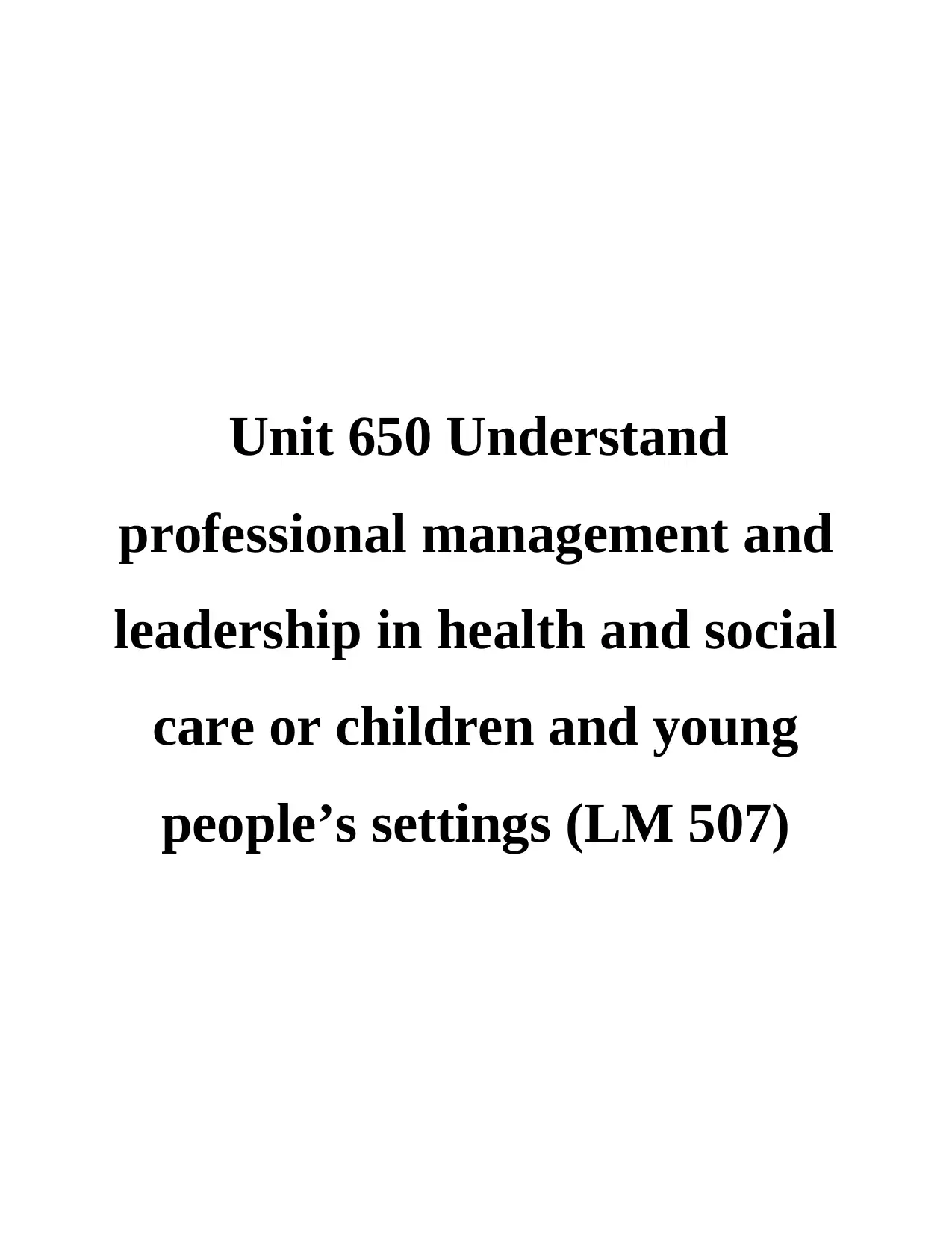
Unit 650 Understand
professional management and
leadership in health and social
care or children and young
people’s settings (LM 507)
professional management and
leadership in health and social
care or children and young
people’s settings (LM 507)
Paraphrase This Document
Need a fresh take? Get an instant paraphrase of this document with our AI Paraphraser
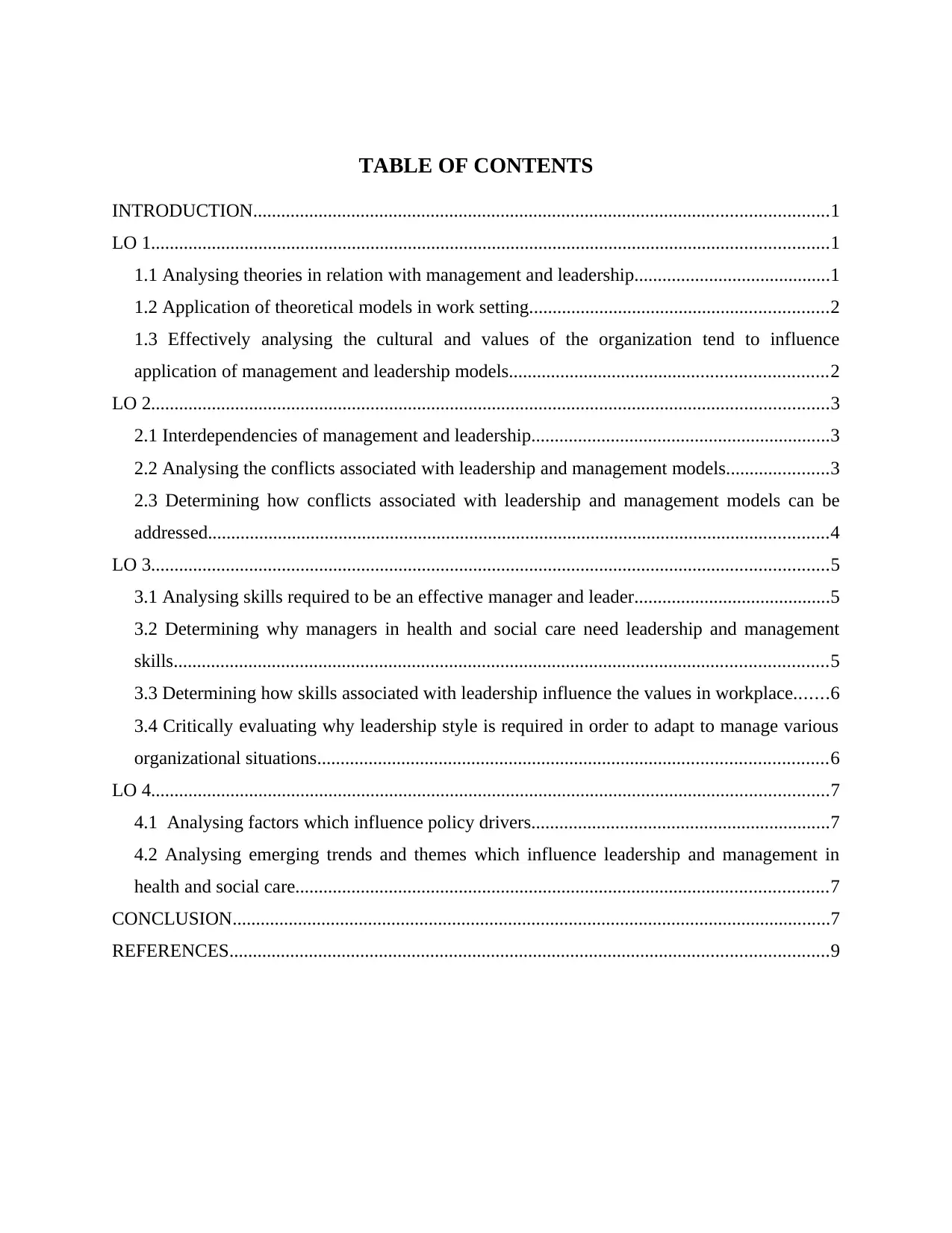
TABLE OF CONTENTS
INTRODUCTION...........................................................................................................................1
LO 1.................................................................................................................................................1
1.1 Analysing theories in relation with management and leadership..........................................1
1.2 Application of theoretical models in work setting................................................................2
1.3 Effectively analysing the cultural and values of the organization tend to influence
application of management and leadership models....................................................................2
LO 2.................................................................................................................................................3
2.1 Interdependencies of management and leadership................................................................3
2.2 Analysing the conflicts associated with leadership and management models......................3
2.3 Determining how conflicts associated with leadership and management models can be
addressed.....................................................................................................................................4
LO 3.................................................................................................................................................5
3.1 Analysing skills required to be an effective manager and leader..........................................5
3.2 Determining why managers in health and social care need leadership and management
skills............................................................................................................................................5
3.3 Determining how skills associated with leadership influence the values in workplace.......6
3.4 Critically evaluating why leadership style is required in order to adapt to manage various
organizational situations.............................................................................................................6
LO 4.................................................................................................................................................7
4.1 Analysing factors which influence policy drivers................................................................7
4.2 Analysing emerging trends and themes which influence leadership and management in
health and social care..................................................................................................................7
CONCLUSION................................................................................................................................7
REFERENCES................................................................................................................................9
INTRODUCTION...........................................................................................................................1
LO 1.................................................................................................................................................1
1.1 Analysing theories in relation with management and leadership..........................................1
1.2 Application of theoretical models in work setting................................................................2
1.3 Effectively analysing the cultural and values of the organization tend to influence
application of management and leadership models....................................................................2
LO 2.................................................................................................................................................3
2.1 Interdependencies of management and leadership................................................................3
2.2 Analysing the conflicts associated with leadership and management models......................3
2.3 Determining how conflicts associated with leadership and management models can be
addressed.....................................................................................................................................4
LO 3.................................................................................................................................................5
3.1 Analysing skills required to be an effective manager and leader..........................................5
3.2 Determining why managers in health and social care need leadership and management
skills............................................................................................................................................5
3.3 Determining how skills associated with leadership influence the values in workplace.......6
3.4 Critically evaluating why leadership style is required in order to adapt to manage various
organizational situations.............................................................................................................6
LO 4.................................................................................................................................................7
4.1 Analysing factors which influence policy drivers................................................................7
4.2 Analysing emerging trends and themes which influence leadership and management in
health and social care..................................................................................................................7
CONCLUSION................................................................................................................................7
REFERENCES................................................................................................................................9
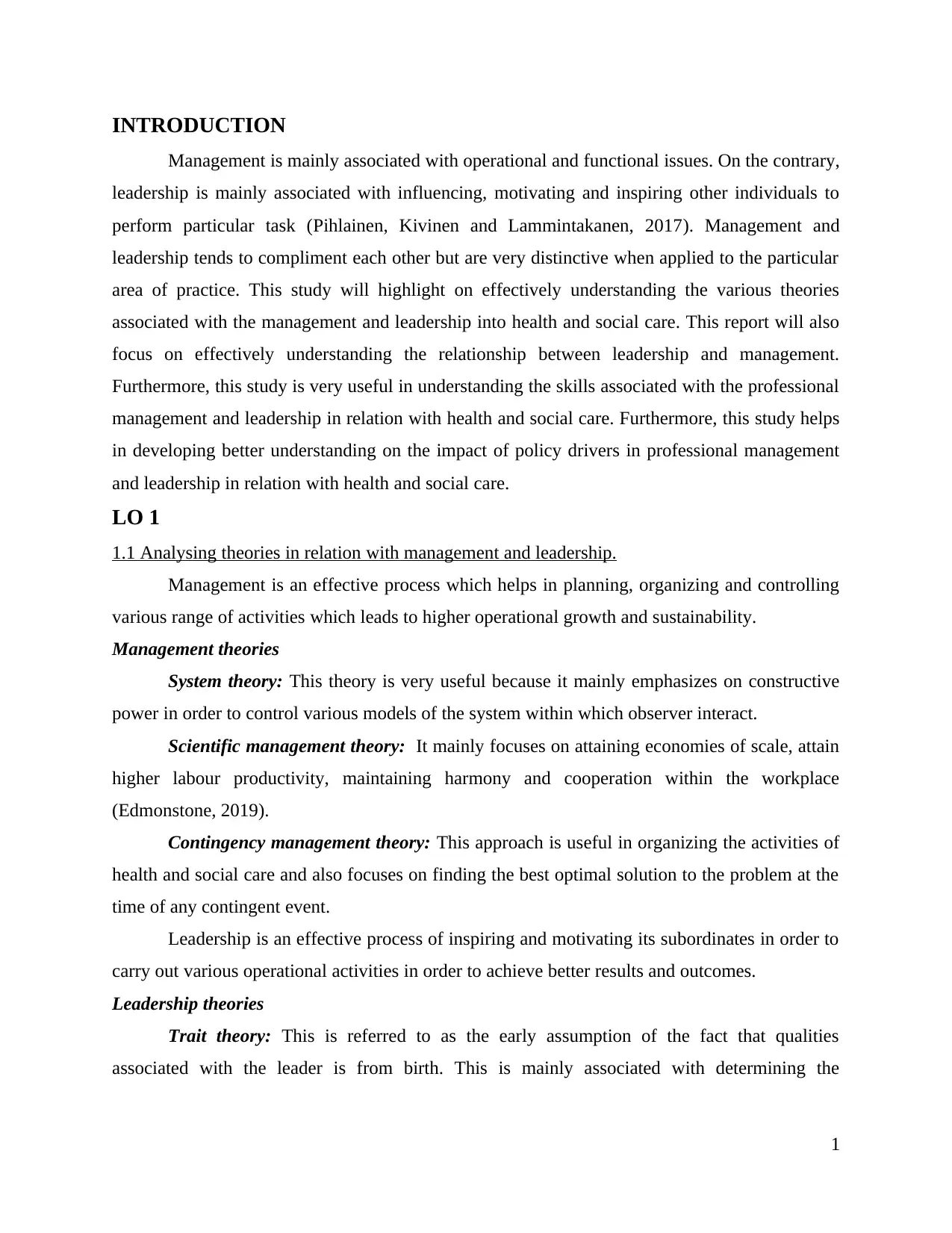
INTRODUCTION
Management is mainly associated with operational and functional issues. On the contrary,
leadership is mainly associated with influencing, motivating and inspiring other individuals to
perform particular task (Pihlainen, Kivinen and Lammintakanen, 2017). Management and
leadership tends to compliment each other but are very distinctive when applied to the particular
area of practice. This study will highlight on effectively understanding the various theories
associated with the management and leadership into health and social care. This report will also
focus on effectively understanding the relationship between leadership and management.
Furthermore, this study is very useful in understanding the skills associated with the professional
management and leadership in relation with health and social care. Furthermore, this study helps
in developing better understanding on the impact of policy drivers in professional management
and leadership in relation with health and social care.
LO 1
1.1 Analysing theories in relation with management and leadership.
Management is an effective process which helps in planning, organizing and controlling
various range of activities which leads to higher operational growth and sustainability.
Management theories
System theory: This theory is very useful because it mainly emphasizes on constructive
power in order to control various models of the system within which observer interact.
Scientific management theory: It mainly focuses on attaining economies of scale, attain
higher labour productivity, maintaining harmony and cooperation within the workplace
(Edmonstone, 2019).
Contingency management theory: This approach is useful in organizing the activities of
health and social care and also focuses on finding the best optimal solution to the problem at the
time of any contingent event.
Leadership is an effective process of inspiring and motivating its subordinates in order to
carry out various operational activities in order to achieve better results and outcomes.
Leadership theories
Trait theory: This is referred to as the early assumption of the fact that qualities
associated with the leader is from birth. This is mainly associated with determining the
1
Management is mainly associated with operational and functional issues. On the contrary,
leadership is mainly associated with influencing, motivating and inspiring other individuals to
perform particular task (Pihlainen, Kivinen and Lammintakanen, 2017). Management and
leadership tends to compliment each other but are very distinctive when applied to the particular
area of practice. This study will highlight on effectively understanding the various theories
associated with the management and leadership into health and social care. This report will also
focus on effectively understanding the relationship between leadership and management.
Furthermore, this study is very useful in understanding the skills associated with the professional
management and leadership in relation with health and social care. Furthermore, this study helps
in developing better understanding on the impact of policy drivers in professional management
and leadership in relation with health and social care.
LO 1
1.1 Analysing theories in relation with management and leadership.
Management is an effective process which helps in planning, organizing and controlling
various range of activities which leads to higher operational growth and sustainability.
Management theories
System theory: This theory is very useful because it mainly emphasizes on constructive
power in order to control various models of the system within which observer interact.
Scientific management theory: It mainly focuses on attaining economies of scale, attain
higher labour productivity, maintaining harmony and cooperation within the workplace
(Edmonstone, 2019).
Contingency management theory: This approach is useful in organizing the activities of
health and social care and also focuses on finding the best optimal solution to the problem at the
time of any contingent event.
Leadership is an effective process of inspiring and motivating its subordinates in order to
carry out various operational activities in order to achieve better results and outcomes.
Leadership theories
Trait theory: This is referred to as the early assumption of the fact that qualities
associated with the leader is from birth. This is mainly associated with determining the
1
⊘ This is a preview!⊘
Do you want full access?
Subscribe today to unlock all pages.

Trusted by 1+ million students worldwide
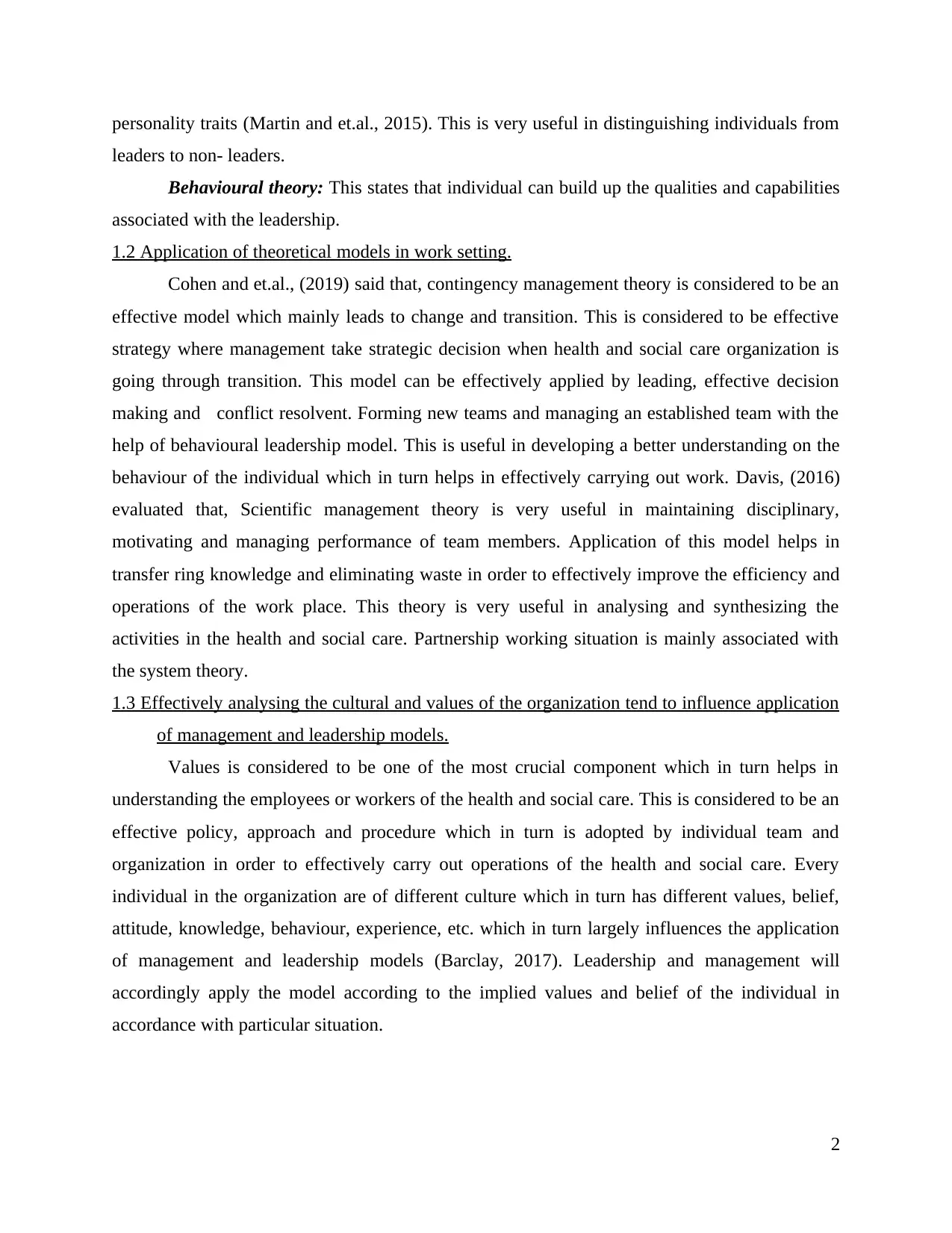
personality traits (Martin and et.al., 2015). This is very useful in distinguishing individuals from
leaders to non- leaders.
Behavioural theory: This states that individual can build up the qualities and capabilities
associated with the leadership.
1.2 Application of theoretical models in work setting.
Cohen and et.al., (2019) said that, contingency management theory is considered to be an
effective model which mainly leads to change and transition. This is considered to be effective
strategy where management take strategic decision when health and social care organization is
going through transition. This model can be effectively applied by leading, effective decision
making and conflict resolvent. Forming new teams and managing an established team with the
help of behavioural leadership model. This is useful in developing a better understanding on the
behaviour of the individual which in turn helps in effectively carrying out work. Davis, (2016)
evaluated that, Scientific management theory is very useful in maintaining disciplinary,
motivating and managing performance of team members. Application of this model helps in
transfer ring knowledge and eliminating waste in order to effectively improve the efficiency and
operations of the work place. This theory is very useful in analysing and synthesizing the
activities in the health and social care. Partnership working situation is mainly associated with
the system theory.
1.3 Effectively analysing the cultural and values of the organization tend to influence application
of management and leadership models.
Values is considered to be one of the most crucial component which in turn helps in
understanding the employees or workers of the health and social care. This is considered to be an
effective policy, approach and procedure which in turn is adopted by individual team and
organization in order to effectively carry out operations of the health and social care. Every
individual in the organization are of different culture which in turn has different values, belief,
attitude, knowledge, behaviour, experience, etc. which in turn largely influences the application
of management and leadership models (Barclay, 2017). Leadership and management will
accordingly apply the model according to the implied values and belief of the individual in
accordance with particular situation.
2
leaders to non- leaders.
Behavioural theory: This states that individual can build up the qualities and capabilities
associated with the leadership.
1.2 Application of theoretical models in work setting.
Cohen and et.al., (2019) said that, contingency management theory is considered to be an
effective model which mainly leads to change and transition. This is considered to be effective
strategy where management take strategic decision when health and social care organization is
going through transition. This model can be effectively applied by leading, effective decision
making and conflict resolvent. Forming new teams and managing an established team with the
help of behavioural leadership model. This is useful in developing a better understanding on the
behaviour of the individual which in turn helps in effectively carrying out work. Davis, (2016)
evaluated that, Scientific management theory is very useful in maintaining disciplinary,
motivating and managing performance of team members. Application of this model helps in
transfer ring knowledge and eliminating waste in order to effectively improve the efficiency and
operations of the work place. This theory is very useful in analysing and synthesizing the
activities in the health and social care. Partnership working situation is mainly associated with
the system theory.
1.3 Effectively analysing the cultural and values of the organization tend to influence application
of management and leadership models.
Values is considered to be one of the most crucial component which in turn helps in
understanding the employees or workers of the health and social care. This is considered to be an
effective policy, approach and procedure which in turn is adopted by individual team and
organization in order to effectively carry out operations of the health and social care. Every
individual in the organization are of different culture which in turn has different values, belief,
attitude, knowledge, behaviour, experience, etc. which in turn largely influences the application
of management and leadership models (Barclay, 2017). Leadership and management will
accordingly apply the model according to the implied values and belief of the individual in
accordance with particular situation.
2
Paraphrase This Document
Need a fresh take? Get an instant paraphrase of this document with our AI Paraphraser
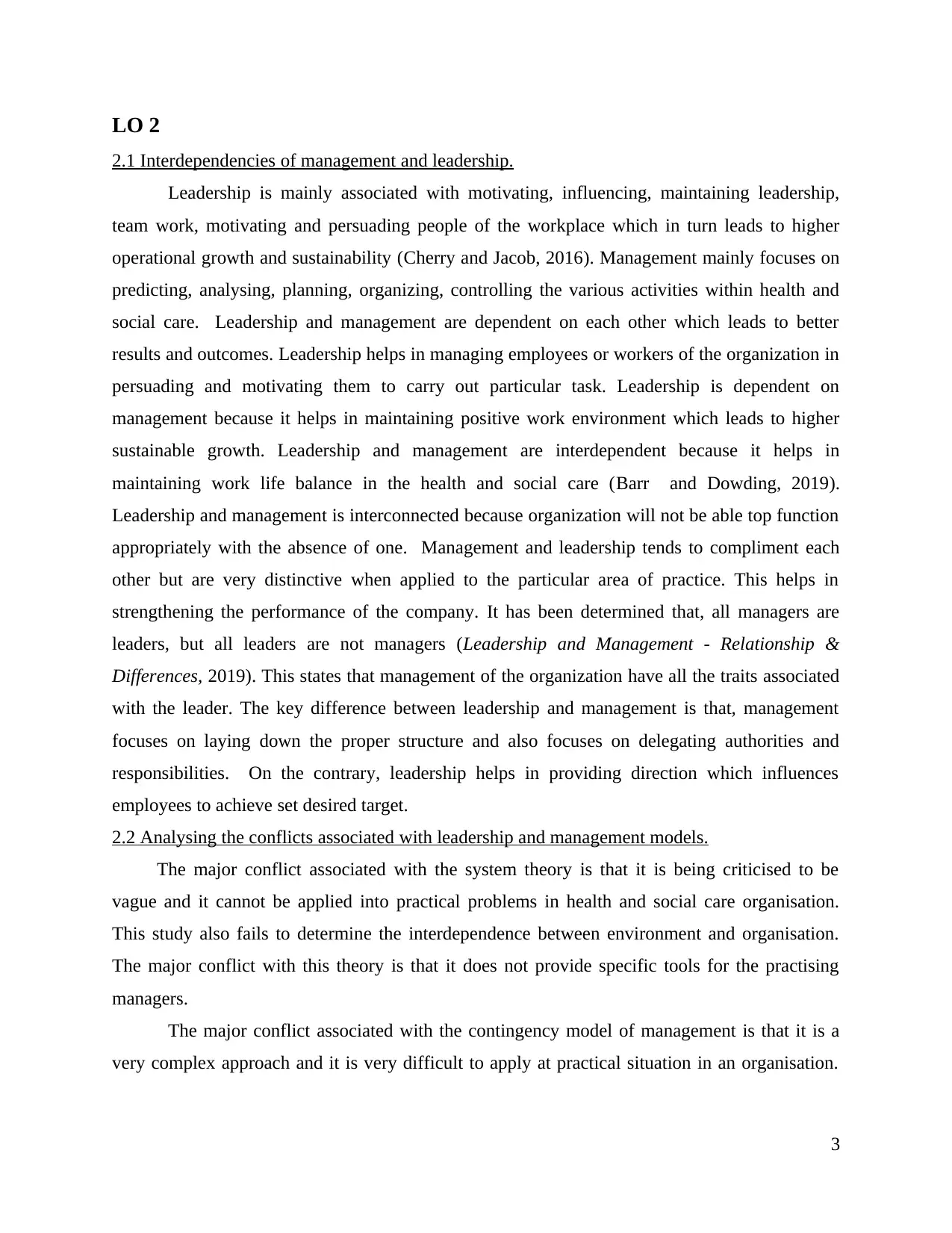
LO 2
2.1 Interdependencies of management and leadership.
Leadership is mainly associated with motivating, influencing, maintaining leadership,
team work, motivating and persuading people of the workplace which in turn leads to higher
operational growth and sustainability (Cherry and Jacob, 2016). Management mainly focuses on
predicting, analysing, planning, organizing, controlling the various activities within health and
social care. Leadership and management are dependent on each other which leads to better
results and outcomes. Leadership helps in managing employees or workers of the organization in
persuading and motivating them to carry out particular task. Leadership is dependent on
management because it helps in maintaining positive work environment which leads to higher
sustainable growth. Leadership and management are interdependent because it helps in
maintaining work life balance in the health and social care (Barr and Dowding, 2019).
Leadership and management is interconnected because organization will not be able top function
appropriately with the absence of one. Management and leadership tends to compliment each
other but are very distinctive when applied to the particular area of practice. This helps in
strengthening the performance of the company. It has been determined that, all managers are
leaders, but all leaders are not managers (Leadership and Management - Relationship &
Differences, 2019). This states that management of the organization have all the traits associated
with the leader. The key difference between leadership and management is that, management
focuses on laying down the proper structure and also focuses on delegating authorities and
responsibilities. On the contrary, leadership helps in providing direction which influences
employees to achieve set desired target.
2.2 Analysing the conflicts associated with leadership and management models.
The major conflict associated with the system theory is that it is being criticised to be
vague and it cannot be applied into practical problems in health and social care organisation.
This study also fails to determine the interdependence between environment and organisation.
The major conflict with this theory is that it does not provide specific tools for the practising
managers.
The major conflict associated with the contingency model of management is that it is a
very complex approach and it is very difficult to apply at practical situation in an organisation.
3
2.1 Interdependencies of management and leadership.
Leadership is mainly associated with motivating, influencing, maintaining leadership,
team work, motivating and persuading people of the workplace which in turn leads to higher
operational growth and sustainability (Cherry and Jacob, 2016). Management mainly focuses on
predicting, analysing, planning, organizing, controlling the various activities within health and
social care. Leadership and management are dependent on each other which leads to better
results and outcomes. Leadership helps in managing employees or workers of the organization in
persuading and motivating them to carry out particular task. Leadership is dependent on
management because it helps in maintaining positive work environment which leads to higher
sustainable growth. Leadership and management are interdependent because it helps in
maintaining work life balance in the health and social care (Barr and Dowding, 2019).
Leadership and management is interconnected because organization will not be able top function
appropriately with the absence of one. Management and leadership tends to compliment each
other but are very distinctive when applied to the particular area of practice. This helps in
strengthening the performance of the company. It has been determined that, all managers are
leaders, but all leaders are not managers (Leadership and Management - Relationship &
Differences, 2019). This states that management of the organization have all the traits associated
with the leader. The key difference between leadership and management is that, management
focuses on laying down the proper structure and also focuses on delegating authorities and
responsibilities. On the contrary, leadership helps in providing direction which influences
employees to achieve set desired target.
2.2 Analysing the conflicts associated with leadership and management models.
The major conflict associated with the system theory is that it is being criticised to be
vague and it cannot be applied into practical problems in health and social care organisation.
This study also fails to determine the interdependence between environment and organisation.
The major conflict with this theory is that it does not provide specific tools for the practising
managers.
The major conflict associated with the contingency model of management is that it is a
very complex approach and it is very difficult to apply at practical situation in an organisation.
3
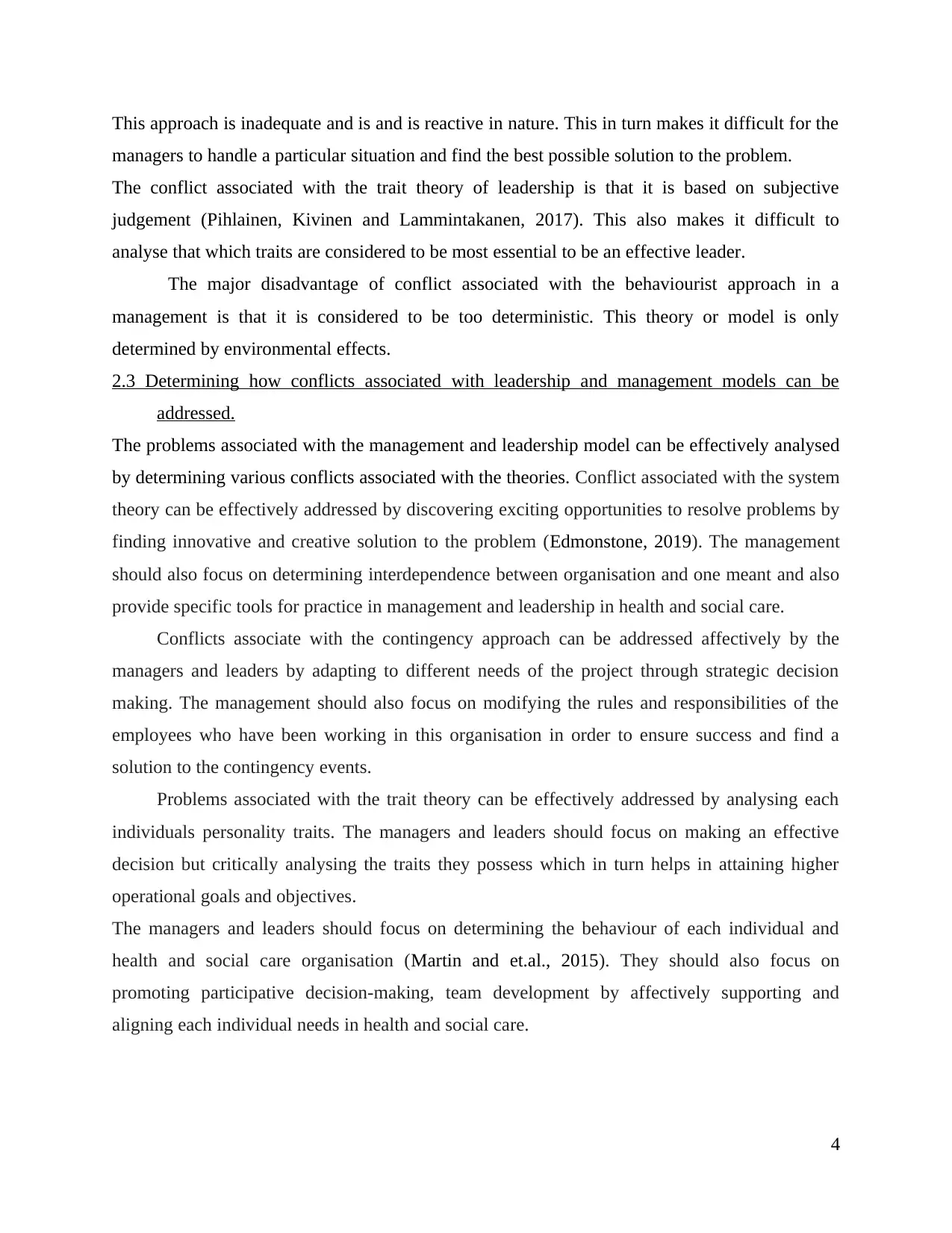
This approach is inadequate and is and is reactive in nature. This in turn makes it difficult for the
managers to handle a particular situation and find the best possible solution to the problem.
The conflict associated with the trait theory of leadership is that it is based on subjective
judgement (Pihlainen, Kivinen and Lammintakanen, 2017). This also makes it difficult to
analyse that which traits are considered to be most essential to be an effective leader.
The major disadvantage of conflict associated with the behaviourist approach in a
management is that it is considered to be too deterministic. This theory or model is only
determined by environmental effects.
2.3 Determining how conflicts associated with leadership and management models can be
addressed.
The problems associated with the management and leadership model can be effectively analysed
by determining various conflicts associated with the theories. Conflict associated with the system
theory can be effectively addressed by discovering exciting opportunities to resolve problems by
finding innovative and creative solution to the problem (Edmonstone, 2019). The management
should also focus on determining interdependence between organisation and one meant and also
provide specific tools for practice in management and leadership in health and social care.
Conflicts associate with the contingency approach can be addressed affectively by the
managers and leaders by adapting to different needs of the project through strategic decision
making. The management should also focus on modifying the rules and responsibilities of the
employees who have been working in this organisation in order to ensure success and find a
solution to the contingency events.
Problems associated with the trait theory can be effectively addressed by analysing each
individuals personality traits. The managers and leaders should focus on making an effective
decision but critically analysing the traits they possess which in turn helps in attaining higher
operational goals and objectives.
The managers and leaders should focus on determining the behaviour of each individual and
health and social care organisation (Martin and et.al., 2015). They should also focus on
promoting participative decision-making, team development by affectively supporting and
aligning each individual needs in health and social care.
4
managers to handle a particular situation and find the best possible solution to the problem.
The conflict associated with the trait theory of leadership is that it is based on subjective
judgement (Pihlainen, Kivinen and Lammintakanen, 2017). This also makes it difficult to
analyse that which traits are considered to be most essential to be an effective leader.
The major disadvantage of conflict associated with the behaviourist approach in a
management is that it is considered to be too deterministic. This theory or model is only
determined by environmental effects.
2.3 Determining how conflicts associated with leadership and management models can be
addressed.
The problems associated with the management and leadership model can be effectively analysed
by determining various conflicts associated with the theories. Conflict associated with the system
theory can be effectively addressed by discovering exciting opportunities to resolve problems by
finding innovative and creative solution to the problem (Edmonstone, 2019). The management
should also focus on determining interdependence between organisation and one meant and also
provide specific tools for practice in management and leadership in health and social care.
Conflicts associate with the contingency approach can be addressed affectively by the
managers and leaders by adapting to different needs of the project through strategic decision
making. The management should also focus on modifying the rules and responsibilities of the
employees who have been working in this organisation in order to ensure success and find a
solution to the contingency events.
Problems associated with the trait theory can be effectively addressed by analysing each
individuals personality traits. The managers and leaders should focus on making an effective
decision but critically analysing the traits they possess which in turn helps in attaining higher
operational goals and objectives.
The managers and leaders should focus on determining the behaviour of each individual and
health and social care organisation (Martin and et.al., 2015). They should also focus on
promoting participative decision-making, team development by affectively supporting and
aligning each individual needs in health and social care.
4
⊘ This is a preview!⊘
Do you want full access?
Subscribe today to unlock all pages.

Trusted by 1+ million students worldwide
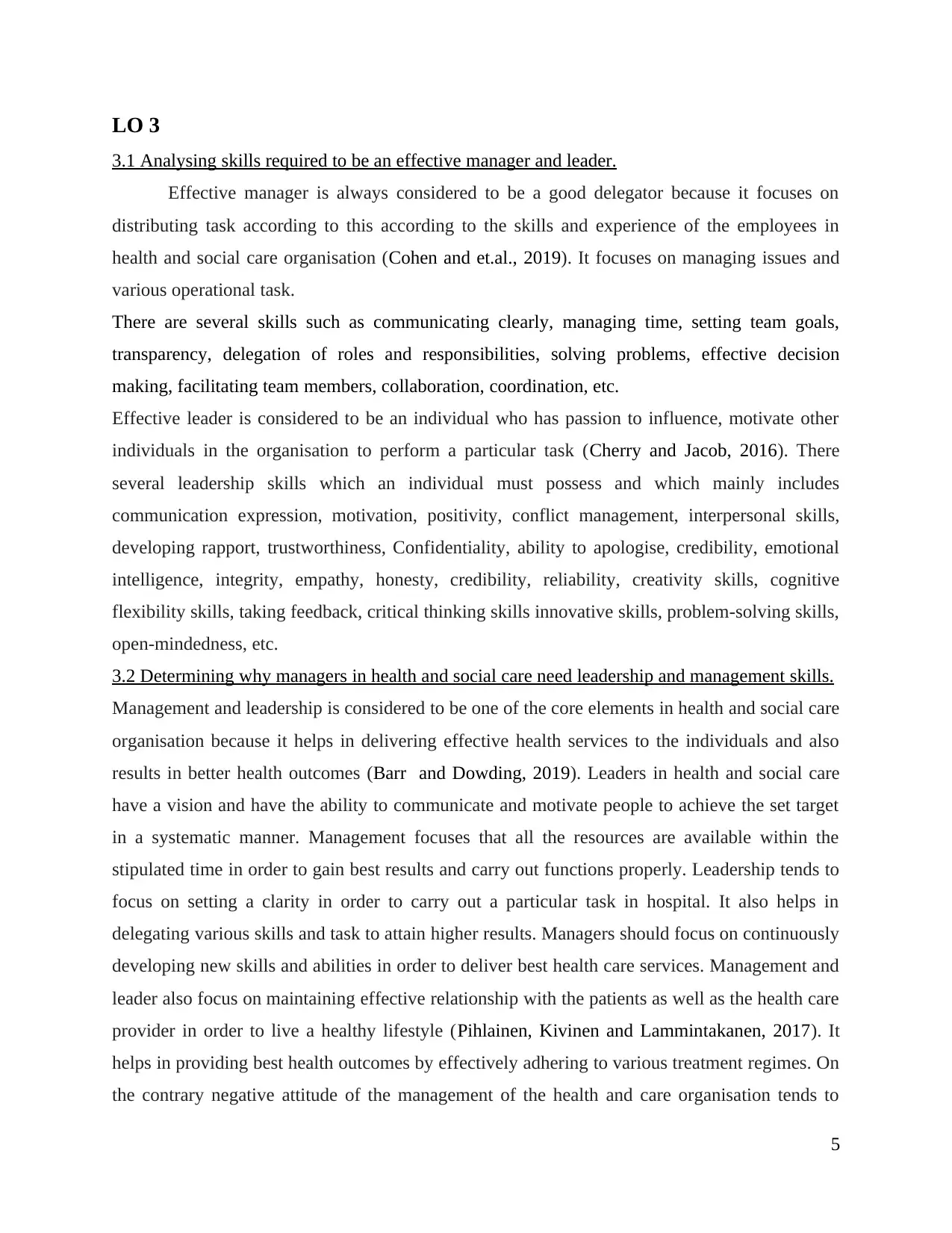
LO 3
3.1 Analysing skills required to be an effective manager and leader.
Effective manager is always considered to be a good delegator because it focuses on
distributing task according to this according to the skills and experience of the employees in
health and social care organisation (Cohen and et.al., 2019). It focuses on managing issues and
various operational task.
There are several skills such as communicating clearly, managing time, setting team goals,
transparency, delegation of roles and responsibilities, solving problems, effective decision
making, facilitating team members, collaboration, coordination, etc.
Effective leader is considered to be an individual who has passion to influence, motivate other
individuals in the organisation to perform a particular task (Cherry and Jacob, 2016). There
several leadership skills which an individual must possess and which mainly includes
communication expression, motivation, positivity, conflict management, interpersonal skills,
developing rapport, trustworthiness, Confidentiality, ability to apologise, credibility, emotional
intelligence, integrity, empathy, honesty, credibility, reliability, creativity skills, cognitive
flexibility skills, taking feedback, critical thinking skills innovative skills, problem-solving skills,
open-mindedness, etc.
3.2 Determining why managers in health and social care need leadership and management skills.
Management and leadership is considered to be one of the core elements in health and social care
organisation because it helps in delivering effective health services to the individuals and also
results in better health outcomes (Barr and Dowding, 2019). Leaders in health and social care
have a vision and have the ability to communicate and motivate people to achieve the set target
in a systematic manner. Management focuses that all the resources are available within the
stipulated time in order to gain best results and carry out functions properly. Leadership tends to
focus on setting a clarity in order to carry out a particular task in hospital. It also helps in
delegating various skills and task to attain higher results. Managers should focus on continuously
developing new skills and abilities in order to deliver best health care services. Management and
leader also focus on maintaining effective relationship with the patients as well as the health care
provider in order to live a healthy lifestyle (Pihlainen, Kivinen and Lammintakanen, 2017). It
helps in providing best health outcomes by effectively adhering to various treatment regimes. On
the contrary negative attitude of the management of the health and care organisation tends to
5
3.1 Analysing skills required to be an effective manager and leader.
Effective manager is always considered to be a good delegator because it focuses on
distributing task according to this according to the skills and experience of the employees in
health and social care organisation (Cohen and et.al., 2019). It focuses on managing issues and
various operational task.
There are several skills such as communicating clearly, managing time, setting team goals,
transparency, delegation of roles and responsibilities, solving problems, effective decision
making, facilitating team members, collaboration, coordination, etc.
Effective leader is considered to be an individual who has passion to influence, motivate other
individuals in the organisation to perform a particular task (Cherry and Jacob, 2016). There
several leadership skills which an individual must possess and which mainly includes
communication expression, motivation, positivity, conflict management, interpersonal skills,
developing rapport, trustworthiness, Confidentiality, ability to apologise, credibility, emotional
intelligence, integrity, empathy, honesty, credibility, reliability, creativity skills, cognitive
flexibility skills, taking feedback, critical thinking skills innovative skills, problem-solving skills,
open-mindedness, etc.
3.2 Determining why managers in health and social care need leadership and management skills.
Management and leadership is considered to be one of the core elements in health and social care
organisation because it helps in delivering effective health services to the individuals and also
results in better health outcomes (Barr and Dowding, 2019). Leaders in health and social care
have a vision and have the ability to communicate and motivate people to achieve the set target
in a systematic manner. Management focuses that all the resources are available within the
stipulated time in order to gain best results and carry out functions properly. Leadership tends to
focus on setting a clarity in order to carry out a particular task in hospital. It also helps in
delegating various skills and task to attain higher results. Managers should focus on continuously
developing new skills and abilities in order to deliver best health care services. Management and
leader also focus on maintaining effective relationship with the patients as well as the health care
provider in order to live a healthy lifestyle (Pihlainen, Kivinen and Lammintakanen, 2017). It
helps in providing best health outcomes by effectively adhering to various treatment regimes. On
the contrary negative attitude of the management of the health and care organisation tends to
5
Paraphrase This Document
Need a fresh take? Get an instant paraphrase of this document with our AI Paraphraser
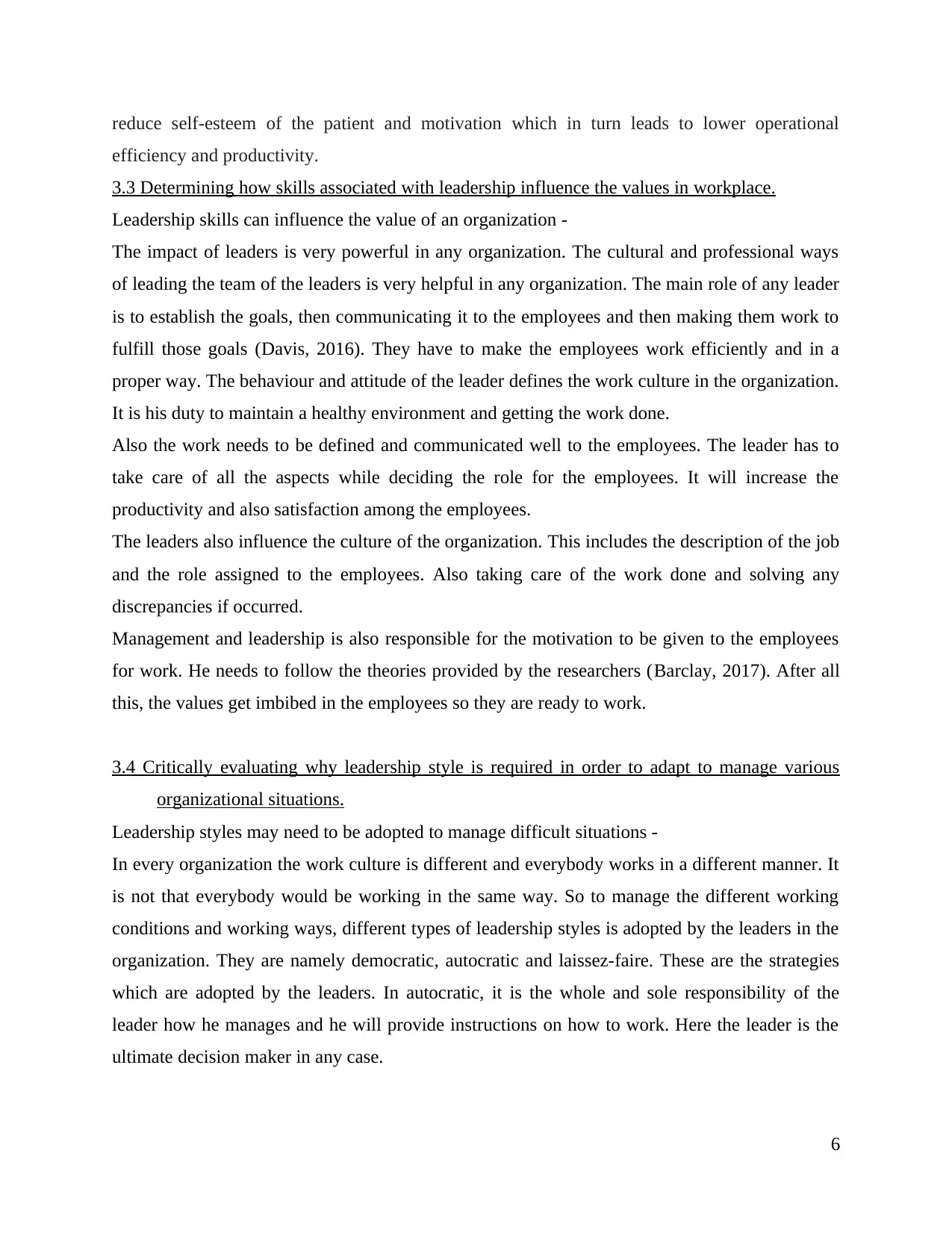
reduce self-esteem of the patient and motivation which in turn leads to lower operational
efficiency and productivity.
3.3 Determining how skills associated with leadership influence the values in workplace.
Leadership skills can influence the value of an organization -
The impact of leaders is very powerful in any organization. The cultural and professional ways
of leading the team of the leaders is very helpful in any organization. The main role of any leader
is to establish the goals, then communicating it to the employees and then making them work to
fulfill those goals (Davis, 2016). They have to make the employees work efficiently and in a
proper way. The behaviour and attitude of the leader defines the work culture in the organization.
It is his duty to maintain a healthy environment and getting the work done.
Also the work needs to be defined and communicated well to the employees. The leader has to
take care of all the aspects while deciding the role for the employees. It will increase the
productivity and also satisfaction among the employees.
The leaders also influence the culture of the organization. This includes the description of the job
and the role assigned to the employees. Also taking care of the work done and solving any
discrepancies if occurred.
Management and leadership is also responsible for the motivation to be given to the employees
for work. He needs to follow the theories provided by the researchers (Barclay, 2017). After all
this, the values get imbibed in the employees so they are ready to work.
3.4 Critically evaluating why leadership style is required in order to adapt to manage various
organizational situations.
Leadership styles may need to be adopted to manage difficult situations -
In every organization the work culture is different and everybody works in a different manner. It
is not that everybody would be working in the same way. So to manage the different working
conditions and working ways, different types of leadership styles is adopted by the leaders in the
organization. They are namely democratic, autocratic and laissez-faire. These are the strategies
which are adopted by the leaders. In autocratic, it is the whole and sole responsibility of the
leader how he manages and he will provide instructions on how to work. Here the leader is the
ultimate decision maker in any case.
6
efficiency and productivity.
3.3 Determining how skills associated with leadership influence the values in workplace.
Leadership skills can influence the value of an organization -
The impact of leaders is very powerful in any organization. The cultural and professional ways
of leading the team of the leaders is very helpful in any organization. The main role of any leader
is to establish the goals, then communicating it to the employees and then making them work to
fulfill those goals (Davis, 2016). They have to make the employees work efficiently and in a
proper way. The behaviour and attitude of the leader defines the work culture in the organization.
It is his duty to maintain a healthy environment and getting the work done.
Also the work needs to be defined and communicated well to the employees. The leader has to
take care of all the aspects while deciding the role for the employees. It will increase the
productivity and also satisfaction among the employees.
The leaders also influence the culture of the organization. This includes the description of the job
and the role assigned to the employees. Also taking care of the work done and solving any
discrepancies if occurred.
Management and leadership is also responsible for the motivation to be given to the employees
for work. He needs to follow the theories provided by the researchers (Barclay, 2017). After all
this, the values get imbibed in the employees so they are ready to work.
3.4 Critically evaluating why leadership style is required in order to adapt to manage various
organizational situations.
Leadership styles may need to be adopted to manage difficult situations -
In every organization the work culture is different and everybody works in a different manner. It
is not that everybody would be working in the same way. So to manage the different working
conditions and working ways, different types of leadership styles is adopted by the leaders in the
organization. They are namely democratic, autocratic and laissez-faire. These are the strategies
which are adopted by the leaders. In autocratic, it is the whole and sole responsibility of the
leader how he manages and he will provide instructions on how to work. Here the leader is the
ultimate decision maker in any case.
6
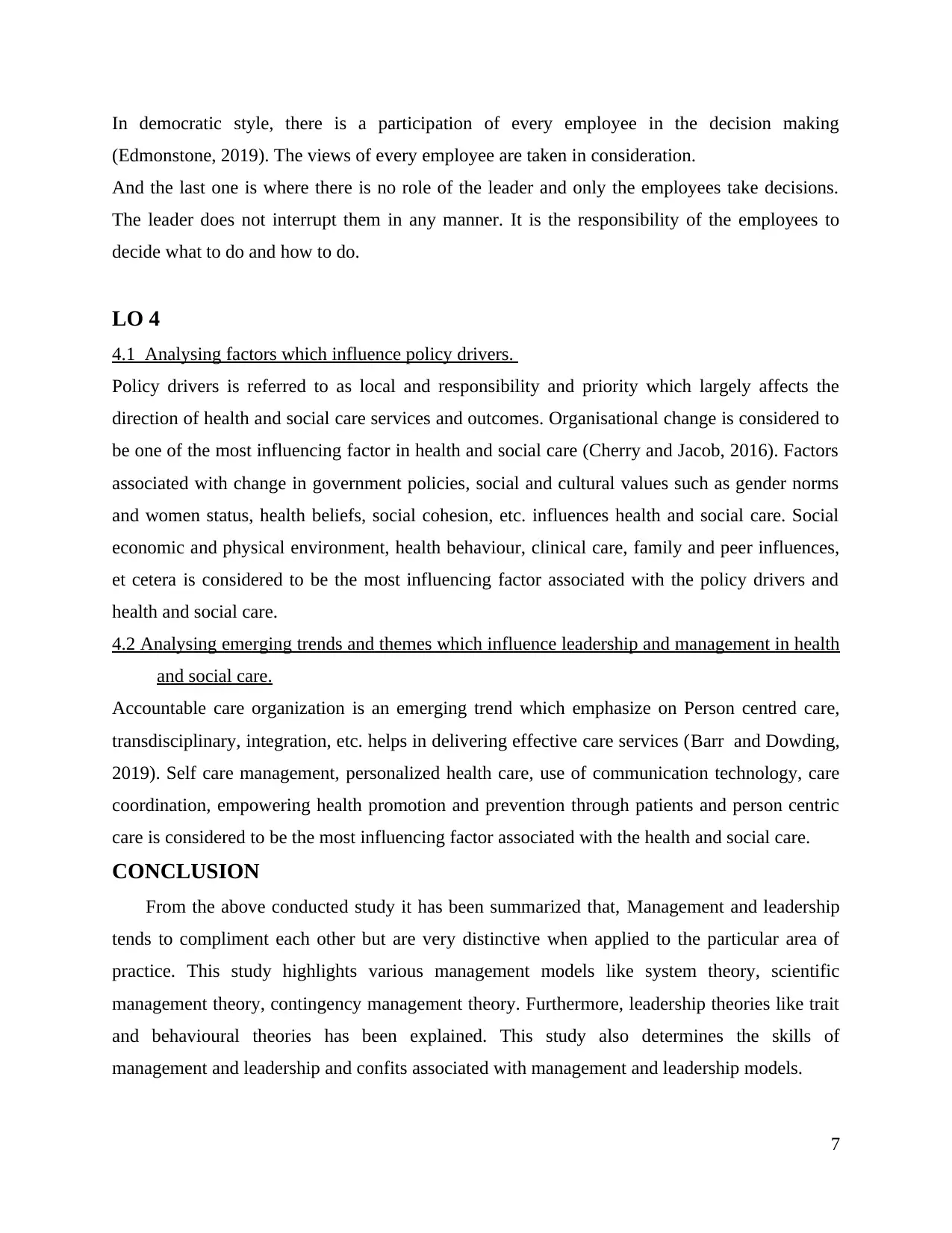
In democratic style, there is a participation of every employee in the decision making
(Edmonstone, 2019). The views of every employee are taken in consideration.
And the last one is where there is no role of the leader and only the employees take decisions.
The leader does not interrupt them in any manner. It is the responsibility of the employees to
decide what to do and how to do.
LO 4
4.1 Analysing factors which influence policy drivers.
Policy drivers is referred to as local and responsibility and priority which largely affects the
direction of health and social care services and outcomes. Organisational change is considered to
be one of the most influencing factor in health and social care (Cherry and Jacob, 2016). Factors
associated with change in government policies, social and cultural values such as gender norms
and women status, health beliefs, social cohesion, etc. influences health and social care. Social
economic and physical environment, health behaviour, clinical care, family and peer influences,
et cetera is considered to be the most influencing factor associated with the policy drivers and
health and social care.
4.2 Analysing emerging trends and themes which influence leadership and management in health
and social care.
Accountable care organization is an emerging trend which emphasize on Person centred care,
transdisciplinary, integration, etc. helps in delivering effective care services (Barr and Dowding,
2019). Self care management, personalized health care, use of communication technology, care
coordination, empowering health promotion and prevention through patients and person centric
care is considered to be the most influencing factor associated with the health and social care.
CONCLUSION
From the above conducted study it has been summarized that, Management and leadership
tends to compliment each other but are very distinctive when applied to the particular area of
practice. This study highlights various management models like system theory, scientific
management theory, contingency management theory. Furthermore, leadership theories like trait
and behavioural theories has been explained. This study also determines the skills of
management and leadership and confits associated with management and leadership models.
7
(Edmonstone, 2019). The views of every employee are taken in consideration.
And the last one is where there is no role of the leader and only the employees take decisions.
The leader does not interrupt them in any manner. It is the responsibility of the employees to
decide what to do and how to do.
LO 4
4.1 Analysing factors which influence policy drivers.
Policy drivers is referred to as local and responsibility and priority which largely affects the
direction of health and social care services and outcomes. Organisational change is considered to
be one of the most influencing factor in health and social care (Cherry and Jacob, 2016). Factors
associated with change in government policies, social and cultural values such as gender norms
and women status, health beliefs, social cohesion, etc. influences health and social care. Social
economic and physical environment, health behaviour, clinical care, family and peer influences,
et cetera is considered to be the most influencing factor associated with the policy drivers and
health and social care.
4.2 Analysing emerging trends and themes which influence leadership and management in health
and social care.
Accountable care organization is an emerging trend which emphasize on Person centred care,
transdisciplinary, integration, etc. helps in delivering effective care services (Barr and Dowding,
2019). Self care management, personalized health care, use of communication technology, care
coordination, empowering health promotion and prevention through patients and person centric
care is considered to be the most influencing factor associated with the health and social care.
CONCLUSION
From the above conducted study it has been summarized that, Management and leadership
tends to compliment each other but are very distinctive when applied to the particular area of
practice. This study highlights various management models like system theory, scientific
management theory, contingency management theory. Furthermore, leadership theories like trait
and behavioural theories has been explained. This study also determines the skills of
management and leadership and confits associated with management and leadership models.
7
⊘ This is a preview!⊘
Do you want full access?
Subscribe today to unlock all pages.

Trusted by 1+ million students worldwide

8
Paraphrase This Document
Need a fresh take? Get an instant paraphrase of this document with our AI Paraphraser
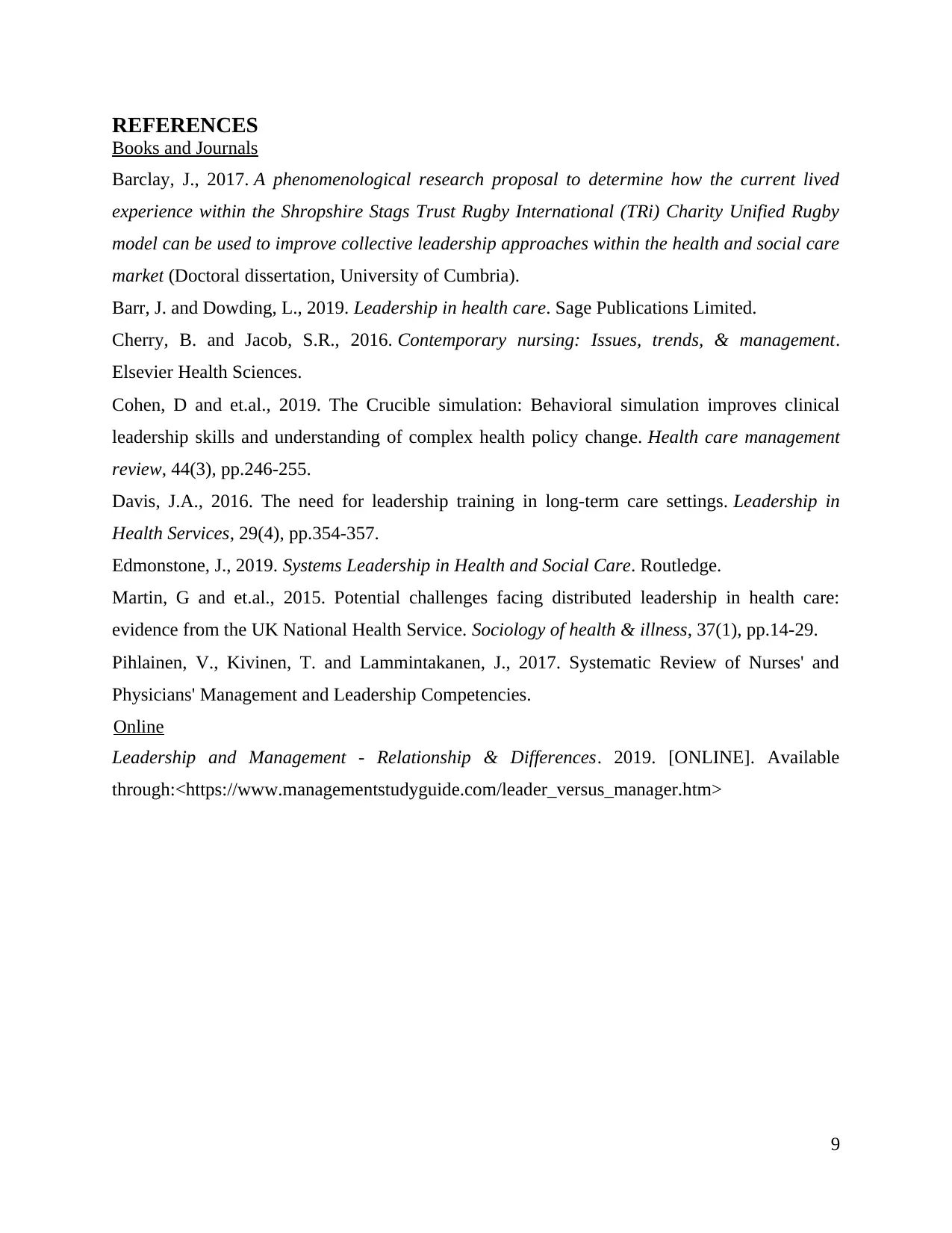
REFERENCES
Books and Journals
Barclay, J., 2017. A phenomenological research proposal to determine how the current lived
experience within the Shropshire Stags Trust Rugby International (TRi) Charity Unified Rugby
model can be used to improve collective leadership approaches within the health and social care
market (Doctoral dissertation, University of Cumbria).
Barr, J. and Dowding, L., 2019. Leadership in health care. Sage Publications Limited.
Cherry, B. and Jacob, S.R., 2016. Contemporary nursing: Issues, trends, & management.
Elsevier Health Sciences.
Cohen, D and et.al., 2019. The Crucible simulation: Behavioral simulation improves clinical
leadership skills and understanding of complex health policy change. Health care management
review, 44(3), pp.246-255.
Davis, J.A., 2016. The need for leadership training in long-term care settings. Leadership in
Health Services, 29(4), pp.354-357.
Edmonstone, J., 2019. Systems Leadership in Health and Social Care. Routledge.
Martin, G and et.al., 2015. Potential challenges facing distributed leadership in health care:
evidence from the UK National Health Service. Sociology of health & illness, 37(1), pp.14-29.
Pihlainen, V., Kivinen, T. and Lammintakanen, J., 2017. Systematic Review of Nurses' and
Physicians' Management and Leadership Competencies.
Online
Leadership and Management - Relationship & Differences. 2019. [ONLINE]. Available
through:<https://www.managementstudyguide.com/leader_versus_manager.htm>
9
Books and Journals
Barclay, J., 2017. A phenomenological research proposal to determine how the current lived
experience within the Shropshire Stags Trust Rugby International (TRi) Charity Unified Rugby
model can be used to improve collective leadership approaches within the health and social care
market (Doctoral dissertation, University of Cumbria).
Barr, J. and Dowding, L., 2019. Leadership in health care. Sage Publications Limited.
Cherry, B. and Jacob, S.R., 2016. Contemporary nursing: Issues, trends, & management.
Elsevier Health Sciences.
Cohen, D and et.al., 2019. The Crucible simulation: Behavioral simulation improves clinical
leadership skills and understanding of complex health policy change. Health care management
review, 44(3), pp.246-255.
Davis, J.A., 2016. The need for leadership training in long-term care settings. Leadership in
Health Services, 29(4), pp.354-357.
Edmonstone, J., 2019. Systems Leadership in Health and Social Care. Routledge.
Martin, G and et.al., 2015. Potential challenges facing distributed leadership in health care:
evidence from the UK National Health Service. Sociology of health & illness, 37(1), pp.14-29.
Pihlainen, V., Kivinen, T. and Lammintakanen, J., 2017. Systematic Review of Nurses' and
Physicians' Management and Leadership Competencies.
Online
Leadership and Management - Relationship & Differences. 2019. [ONLINE]. Available
through:<https://www.managementstudyguide.com/leader_versus_manager.htm>
9
1 out of 11
Related Documents
Your All-in-One AI-Powered Toolkit for Academic Success.
+13062052269
info@desklib.com
Available 24*7 on WhatsApp / Email
![[object Object]](/_next/static/media/star-bottom.7253800d.svg)
Unlock your academic potential
Copyright © 2020–2025 A2Z Services. All Rights Reserved. Developed and managed by ZUCOL.





